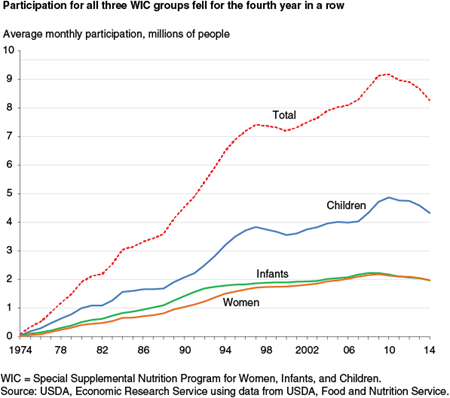WIC Experienced Largest Decrease in Participation in Program’s History in 2014

USDA’s Special Supplemental Nutrition Program for Women, Infants, and Children (WIC) provides supplemental food, nutrition education, and health care referrals to low-income, nutritionally at-risk pregnant, breastfeeding, and postpartum women as well as infants and children up to age 5. In fiscal 2014, an average 8.3 million people per month participated in the program, 5 percent fewer than the previous year. This was the largest 1-year decrease since the program’s inception in 1974. Since peaking in fiscal 2010, the number of participants has decreased by almost 10 percent.
With annual Federal expenditures of $6.2 billion in fiscal 2014, WIC is the Nation’s third-largest food and nutrition assistance program. WIC is based on the premise that early intervention during critical times of growth and development can help prevent future medical and developmental problems. On average, over half of all infants in the United States, over a quarter of all pregnant and postpartum women, and over a quarter of all children less than 5 years of age participate in the program.
In general, the number of children in WIC has fluctuated more than the number of women and infants. This trend continued in fiscal 2014 as the number of women fell by 4 percent, the number of infants fell by 3 percent and the number of children fell by 6 percent. This marked the fourth consecutive year—and only the fourth year in the program’s history—that participation for all three groups fell.
Falling WIC caseloads reflect the continued decline in the number of U.S. births, which began in 2008. In 2013 (latest data available), 3.9 million babies were born in the United States, down from 4.3 million in 2007. Fewer births reduce the potential pool of WIC-eligible participants. Improving economic conditions in recent years may have also played a role in the decline in participation. The number of people in poverty fell in 2013, and in 2014, the unemployment rate decreased for the fourth consecutive year. Since applicants’ incomes must be at or below 185 percent of poverty, the number of people eligible for WIC is closely linked to the health of the economy.
The Food Assistance Landscape: FY 2014 Annual Report, by Victor Oliveira, USDA, Economic Research Service, March 2015


